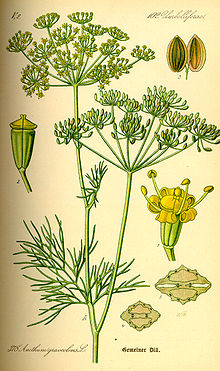Dill weed
| Dill | |
|---|---|
 |
|
| 1885 illustration | |
| Scientific classification | |
| Kingdom: | Plantae |
| (unranked): | Angiosperms |
| (unranked): | Eudicots |
| (unranked): | Asterids |
| Order: | Apiales |
| Family: | Apiaceae |
| Genus: |
Anethum L. |
| Species: | A. graveolens |
| Binomial name | |
|
Anethum graveolens L. |
|
| Synonyms | |
|
Synonymy
|
|
| Nutritional value per 100 g (3.5 oz) | |
|---|---|
| Energy | 180 kJ (43 kcal) |
|
7 g
|
|
| Dietary fiber | 2.1 g |
|
1.1 g
|
|
|
3.5 g
|
|
| Vitamins | |
| Vitamin A | 7717 (154%) IU |
| Thiamine (B1) |
(9%)
0.1 mg |
| Riboflavin (B2) |
(25%)
0.3 mg |
| Niacin (B3) |
(11%)
1.6 mg |
| Pantothenic acid (B5) |
(8%)
0.4 mg |
| Vitamin B6 |
(15%)
0.2 mg |
| Folate (B9) |
(38%)
150 μg |
| Vitamin B12 |
(0%)
0 μg |
| Vitamin C |
(102%)
85 mg |
| Minerals | |
| Calcium |
(21%)
208 mg |
| Iron |
(51%)
6.6 mg |
| Magnesium |
(15%)
55 mg |
| Manganese |
(62%)
1.3 mg |
| Phosphorus |
(9%)
66 mg |
| Potassium |
(16%)
738 mg |
| Sodium |
(4%)
61 mg |
| Zinc |
(9%)
0.9 mg |
| Other constituents | |
| Copper | 0.14 mg (7%) |
|
|
| Percentages are roughly approximated using US recommendations for adults. Source: USDA Nutrient Database |
|
Dill (Anethum graveolens) is an annual herb in the celery family Apiaceae.
It is the sole species of the genus Anethum.
Dill grows up to 40–60 cm (16–24 in), with slender hollow stems and alternate, finely divided, softly delicate leaves 10–20 cm (3.9–7.9 in) long. The ultimate leaf divisions are 1–2 mm (0.039–0.079 in) broad, slightly broader than the similar leaves of fennel, which are threadlike, less than 1 mm (0.039 in) broad, but harder in texture. The flowers are white to yellow, in small umbels 2–9 cm (0.79–3.54 in) diameter. The seeds are 4–5 mm (0.16–0.20 in) long and 1 mm (0.039 in) thick, and straight to slightly curved with a longitudinally ridged surface.
"Dill" is a Germanic word whose origin is unknown.
Fresh and dried dill leaves (sometimes called "dill weed" to distinguish it from dill seed) are widely used as herbs in Europe and central Asia.
Like caraway, the fernlike leaves of dill are aromatic and are used to flavor many foods such as gravlax (cured salmon) and other fish dishes, borscht and other soups, as well as pickles (where the dill flower is sometimes used). Dill is best when used fresh as it loses its flavor rapidly if dried; however, freeze-dried dill leaves retain their flavor relatively well for a few months.
Dill seed, having a flavor similar to caraway but also resembling that of fresh or dried dill weed, is used as a spice. Dill oil is extracted from the leaves, stems and seeds of the plant. The oil from the seeds is distilled and used in the manufacturing of soaps.
...
Wikipedia
